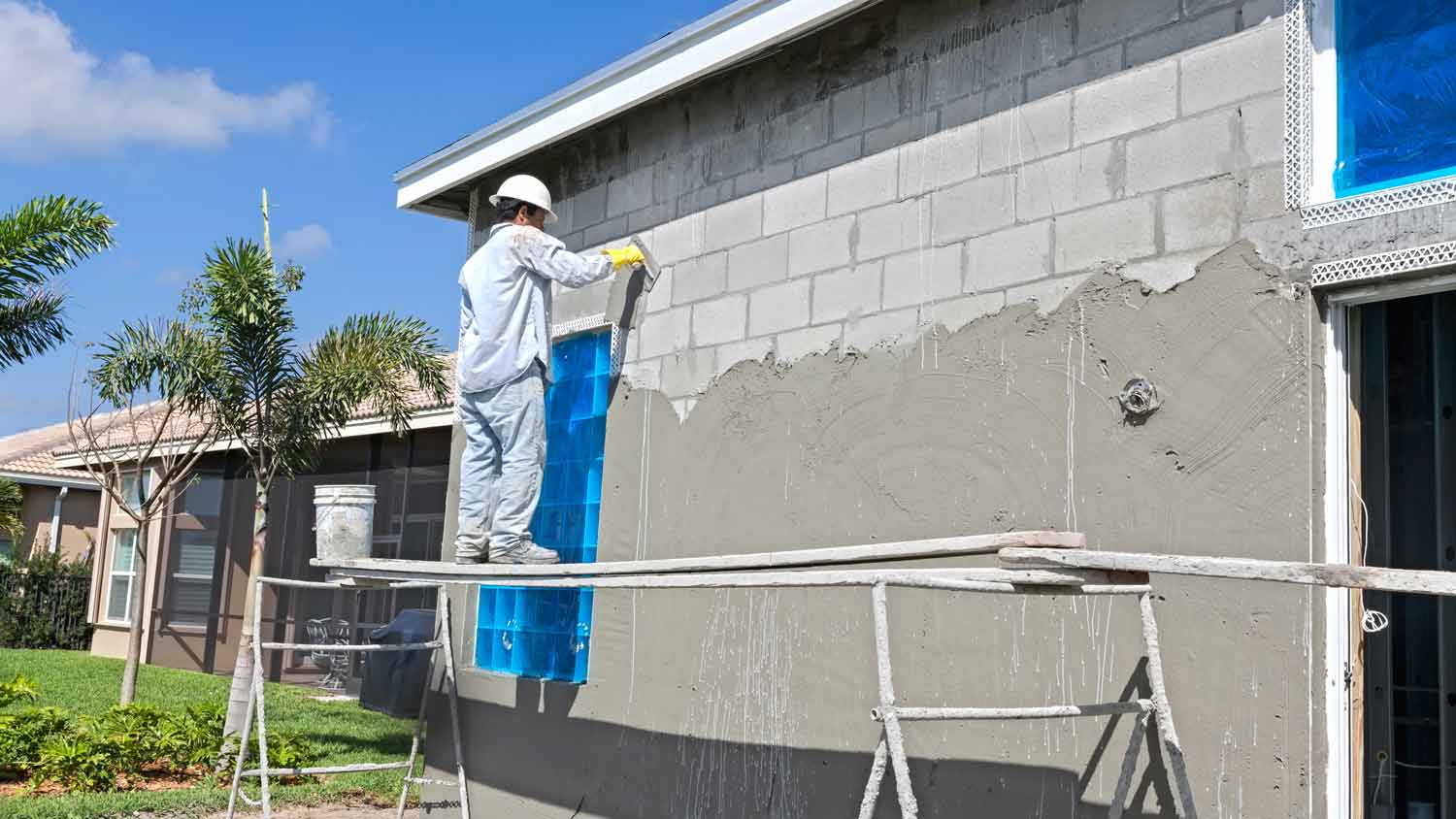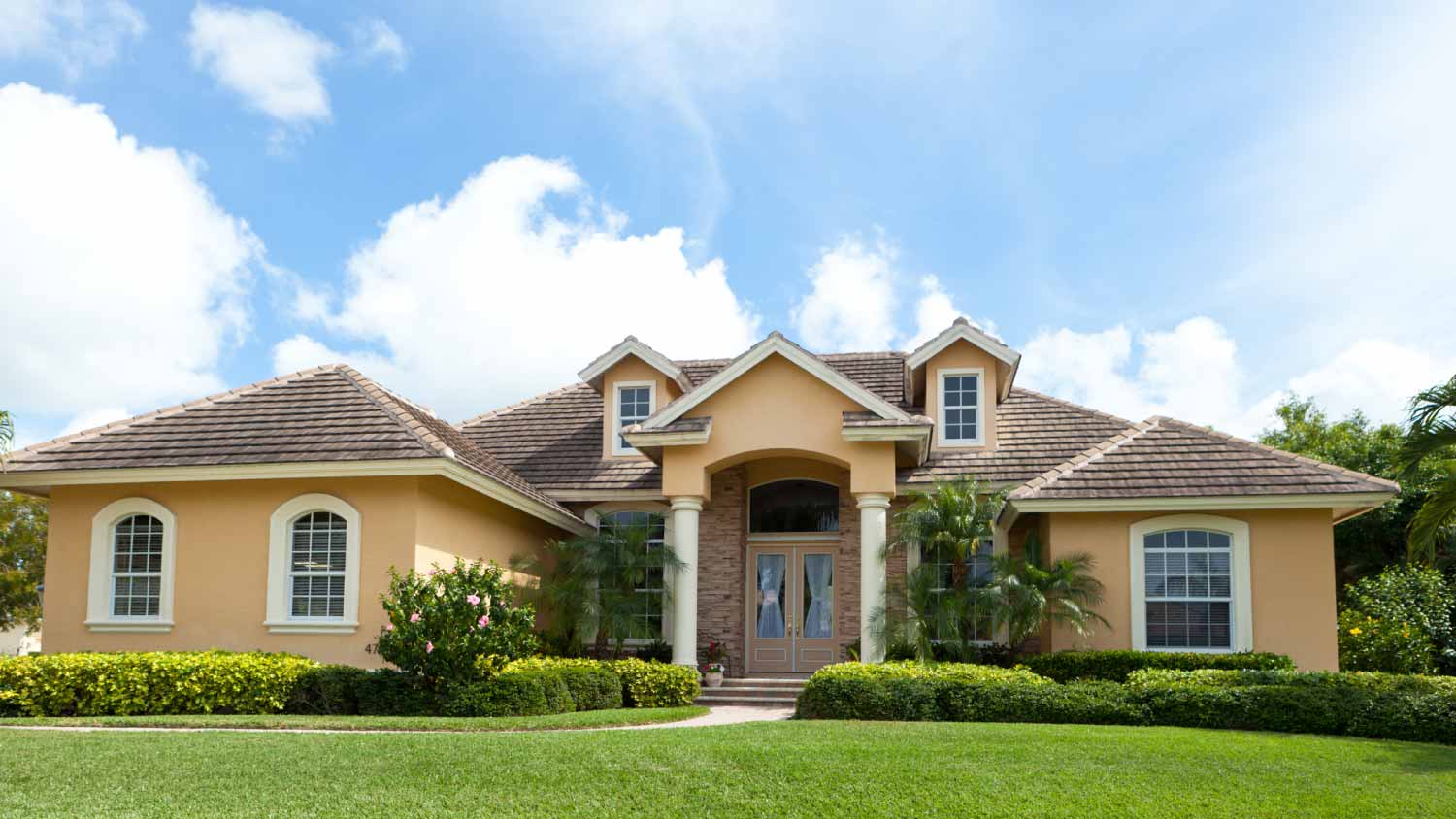
Discover the average stucco repair cost, key price factors, and ways to save. Get expert tips to budget your stucco repair project with confidence.
Will stucco stick?


Proper preparation is important when adding stucco over brick to ensure the new stucco adheres to the surface.
Stucco is prized for its beauty, durability, and eco-friendly properties.
While stucco has many advantages, homeowners will need to be prepared for the extra maintenance required with this option.
Installing stucco requires expertise, so rely on a pro for this job.
If you’ve been thinking about how to revamp your curb appeal, you may be wondering if you can stucco over brick. While this may seem like a good way to update brick siding without a major construction project, there are some things to know about choosing stucco. Here's a look at what every homeowner with a transformation on their mind needs to know about putting stucco over brick.
Yes, it is possible to add stucco over brick to change the look of your siding. However, this isn't a project to take lightly. You'll need to start with impeccable preparation in order to ensure the stucco successfully sticks to the brick and your siding update lasts. You should prep the brick surface by repairing any cracked or broken bricks before applying stucco layers.
It's also important to stucco your brick during the right time of year. Ideally, stucco work should be done on overcast days with temperatures between 50 and 60 degrees so your stucco has time to dry properly. Never do stucco work in freezing or sweltering temperatures.
Finally, make sure your home's siding is real brick before beginning this project. The issue of stuccoing over brick is very different when it comes to brick veneer versus brick. While stucco can be layered over brick, brick veneers will need to be removed before new siding can be placed.
There are many reasons why homeowners choose to update their brick homes by adding stucco. Your own motivation for a siding update may be either aesthetic or practical. Here's a look at the pros of stuccoing over brick.
When installed correctly, stucco is a durable material that can potentially enhance protection against fire, termites, water damage, and mold. Properly installed stucco can even last up to 50 years or more, which for homeowners can mean never having to replace siding again. Stucco also retains its color for far longer than other siding options. Unlike wood, which needs to be repainted every few years, stucco will retain its vibrant color. You can even simulate the look of brick with stucco while adding longevity and protection.
One of the exciting things about stuccoing over brick is that you can customize the texture of your new siding. Stucco's texture is determined during the layering process, and many homeowners appreciate the way stucco allows them to achieve a custom, high-end look. Stucco could even help boost a home's value by increasing curb appeal.
Stucco is considered one of the most environmentally friendly siding options. First, stucco's longevity means that siding won't need to be discarded for decades. Second, stucco is made from natural materials. Lastly, stucco's strong insulation properties can also help homeowners reduce energy consumption when heating and cooling homes.

While there's a lot to like about stucco, it does come with some disadvantages that need to be considered. Stucco is very different from vinyl, wood, and other common siding options. Here's what you need to know if you're thinking about adding stucco over brick.
While stucco is a long-lasting option, it does require routine maintenance to stay in top shape. Learning how to clean stucco without damaging it is essential for its longevity. The distinct texture of stucco means that regular cleaning is necessary to prevent stucco from being overrun by dirt, mud, pollen, and other types of outdoor debris. Luckily, hosing down the siding regularly is enough to take care of this.
Rigidity is something to consider when looking at vinyl or fiber cement versus stucco. Stucco isn't as pliable as options like vinyl siding and fiber cement. As a result, it can be more prone to cracking, which occurs when a home naturally settles over the years. Homeowners with stucco siding need to inspect their homes routinely to spot any subtle cracks. All cracks and holes need to be fixed immediately to preserve the integrity of the stucco.
If you need to add fixtures or other features to your siding, it's important to know how to drill into stucco properly to avoid causing cracks.
While well-maintained stucco is generally resistant to water damage and mold, poor maintenance can put stucco at risk. Stucco is vulnerable to water damage because it has a tendency to hold moisture. If you're planning to add stucco over brick, make sure that flashing around all your windows and doors is in perfect shape to prevent water from snaking its way through your existing brick and new stucco layer.
Can you stucco over brick with any type of house? Adding stucco can be a delicate situation. For this reason, it's recommended that you have your current siding looked at by a professional who installs stucco to get an honest assessment of the prep work needed to make your dream of stucco siding a smart reality. Some things to consider before making the decision to stucco over brick include:
Do you have a clear picture of what’s required to maintain stucco to extend its life and get the most protection out of the material?
Is your brick in good enough condition to support applying stucco over it?
Will you like the aesthetics of stucco over brick?
Do you know what to look for to see if your stucco requires repair or replacement?
Additionally, the complexity and time-consuming nature behind how to stucco a house means that you should have stucco siding added using professional stucco services near you.
Because stucco is a labor-intensive project, you can expect higher costs to add stucco over brick—though it’s still mid-range compared to other house siding options. Stuccoing over brick costs about $7 per square foot. For a 1,500-square-foot home, that would cost about $10,500.
Although different textures are available, whichever you choose shouldn’t have a big effect on the cost. There also isn’t a big price difference between synthetic stucco and traditional stucco. The biggest factor is the size of the house.
From average costs to expert advice, get all the answers you need to get your job done.

Discover the average stucco repair cost, key price factors, and ways to save. Get expert tips to budget your stucco repair project with confidence.

Get transparent stucco inspection cost info. Learn what impacts price, how to save, and what to expect before hiring a pro for your stucco inspection.

Discover the cost to stucco a house in 2025, including average prices, key factors, and tips to help you budget and plan your stucco project with confidence.

Stucco and brick are popular exterior siding options. Learn the key differences between stucco and brick so you can choose the right one for your home.

Wondering if stucco increases home value? The short answer is, yes, but the ROI you’ll see depends on a few factors, like location and installation costs.

Traditional stucco and synthetic stucco are two excellent options for your home. Both materials can last 50 years or more, and can provide excellent protection for your home against the elements.